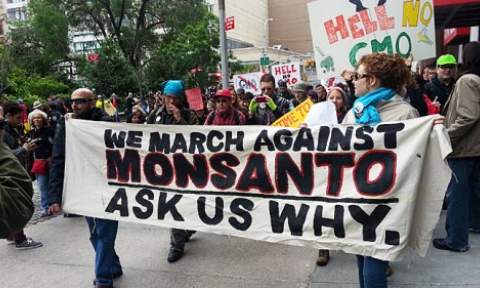
Waking Times
Here is an excellent collection of scientific papers finding adverse biological effects or damage to health from Wi-Fi signals, Wi-Fi-enabled devices or Wi-Fi frequencies (2.4 or 5 GHz), complied by campaign group WiFi In Schools.
The papers listed are only those where exposures were 16V/m or below. Someone using a Wi-Fi-enabled tablet computer can be exposed to electromagnetic fields up to 16V/m. Papers are in alphabetical order. A file of first pages, for printing, can be found here.
If you feel like sending a copy of this collection to the local schools in your area, you can search for them here and either print out this article to post or email the link.
Wi-Fi papers
1. Atasoy H.I. et al., 2013. Immunohistopathologic demonstration of deleterious effects on growing rat testes of radiofrequency waves emitted from conventional Wi-Fi devices. Journal of Pediatric Urology 9(2): 223-229. http://www.ncbi.nlm.nih.gov/pubmed/22465825
2. Avendaño C. et al., 2012. Use of laptop computers connected to internet through Wi-Fi decreases human sperm motility and increases sperm DNA fragmentation. Fertility and Sterility 97(1): 39-45. http://www.ncbi.nlm.nih.gov/pubmed/22112647
3. Avendaño C. et al., 2010. Laptop expositions affect motility and induce DNA fragmentation in human spermatozoa in vitro by a non-thermal effect: a preliminary report. American Society for Reproductive Medicine 66th Annual Meeting: O-249http://wifiinschools.org.uk/resources/laptops+and+sperm.pdf)
4. Aynali G. et al., 2013. Modulation of wireless (2.45 GHz)-induced oxidative toxicity in laryngotracheal mucosa of rat by melatonin. Eur Arch Otorhinolaryngol 270(5): 1695-1700.http://www.ncbi.nlm.nih.gov/pubmed/23479077
5. Gumral N. et al., 2009. Effects of selenium and L-carnitine on oxidative stress in blood of rat induced by 2.45-GHz radiation from wireless devices. Biol Trace Elem Res. 132(1-3): 153-163.http://www.ncbi.nlm.nih.gov/pubmed/19396408
6. Havas M. et al., 2010. Provocation study using heart rate variability shows microwave radiation from 2.4GHz cordless phone affects autonomic nervous system. European Journal of Oncology Library Vol. 5: 273-300. http://www.icems.eu/papers.htm?f=/c/a/2009/12/15/MNHJ1B49KH.DTL part 2.
7. Havas M. and Marrongelle J. 2013. Replication of heart rate variability provocation study with 2.45GHz cordless phone confirms original findings. Electromagn Biol Med 32(2): 253-266.https://www.ncbi.nlm.nih.gov/pubmed/23675629
8. Maganioti A. E. et al., 2010. Wi-Fi electromagnetic fields exert gender related alterations on EEG. 6th International Workshop on Biological Effects of Electromagnetic fields.http://www.istanbul.edu.tr/6internatwshopbioeffemf/cd/pdf/poster/WI-FI%20ELECTROMAGNETIC%20FIELDS%20EXERT%20GENDER.pdf
9. Margaritis L.H. et al., 2013. Drosophila oogenesis as a bio-marker responding to EMF sources.
Electromagn Biol Med., Epub ahead of print. http://www.ncbi.nlm.nih.gov/pubmed/23915130
10. Naziroğlu M. and Gumral 2009. Modulator effects of L-carnitine and selenium on wireless devices (2.45 GHz)-induced oxidative stress and electroencephalography records in brain of rat. Int J Radiat Biol. 85(8): 680-689. http://www.ncbi.nlm.nih.gov/pubmed/19637079
11. Nazıroğlu M. et al., 2012. 2.45-Gz wireless devices induce oxidative stress and proliferation through cytosolic Ca2+ influx in human leukemia cancer cells. International Journal of Radiation Biology 88(6): 449–456. http://www.ncbi.nlm.nih.gov/pubmed/22489926
12. Nazıroğlu M. et al., 2012b. Melatonin modulates wireless (2.45 GHz)-induced oxidative injury through TRPM2 and voltage gated Ca(2+) channels in brain and dorsal root ganglion in rat. Physiol Behav. 105(3): 683-92. http://www.ncbi.nlm.nih.gov/pubmed/22019785
13. Oksay T. et al., 2012. Protective effects of melatonin against oxidative injury in rat testis induced by wireless (2.45 GHz) devices. Andrologia doi: 10.1111/and.12044, Epub ahead of print.http://www.ncbi.nlm.nih.gov/pubmed/23145464
14. Papageorgiou C. C. et al., 2011. Effects of Wi-Fi signals on the p300 component of event-related potentials during an auditory hayling task. Journal of Integrative Neuroscience 10(2): 189-202. http://www.ncbi.nlm.nih.gov/pubmed/21714138 (Wi-Fi alters brain activity in young adults:http://wifiinschools.org.uk/resources/wifi+brain+July+2011.pdf)
15. Shahin S. et al., 2013. 2.45 GHz Microwave Irradiation-Induced Oxidative Stress Affects Implantation or Pregnancy in Mice, Mus musculus. Appl Biochem Biotechnol 169: 1727–1751.http://www.ncbi.nlm.nih.gov/pubmed/23334843
16. Türker Y. et al., 2011. Selenium and L-carnitine reduce oxidative stress in the heart of rat induced by 2.45-GHz radiation from wireless devices. Biol Trace Elem Res. 143(3): 1640-1650.http://www.ncbi.nlm.nih.gov/pubmed/21360060
And here are a few more studies of similar microwave frequencies at low exposures (6V/m or below) (this is not comprehensive):
17. Balmori A. 2010. Mobile phone mast effects on common frog (Rana temporaria) tadpoles: the city turned into a laboratory. Electromagn. Biol. Med. 29(1-2):31-35. http://www.ncbi.nlm.nih.gov/pubmed/20560769
18. Erdinc O. O. et al., 2003. Electromagnetic waves of 900MHz in acute pentylenetetrazole model in ontogenesis in mice. Neurol. Sci. 24:111-116 http://www.ncbi.nlm.nih.gov/pubmed/14600821
19. Fesenko E. E. et al., 1999. Stimulation of murine natural killer cells by weak electromagnetic waves in the centimeter range. Biofizika 44:737–741http://www.ncbi.nlm.nih.gov/pubmed/10544828
20. Fesenko E. E. et al., 1999. Microwaves and cellular immunity. I. Effect of whole body microwave irradiation on tumor necrosis factor production in mouse cells, Bioelectrochem. Bioenerg. 49:29–35 http://www.ncbi.nlm.nih.gov/pubmed/10619445
21. Havas M. et al., 2010. Provocation study using heart rate variability shows microwave radiation from 2.4GHz cordless phone affects autonomic nervous system. European Journal of OncologyLibrary Vol. 5: 273-300 http://www.icems.eu/papers.htm?f=/c/a/2009/12/15/MNHJ1B49KH.DTL part 2.
22. Kesari K. K. and Behari J., 2009. Microwave exposure affecting reproductive system in male rats. Appl. Biochem. Biotechnol. 162(2):416-428 http://www.ncbi.nlm.nih.gov/pubmed/19768389
23. Kesari K. K. and Behari J., 2009. Fifty-gigahertz microwave exposure effect of radiations on rat brain. Appl. Biochem. Biotechnol. 158:126-139 http://www.ncbi.nlm.nih.gov/pubmed/19089649
24. Khurana V. G. et al., 2010. Epidemiological Evidence for a Health Risk from Mobile Phone Base Stations. Int. J. Occup. Environ. Health 16:263–267http://www.ncbi.nlm.nih.gov/pubmed/20662418
25. Maier R. et al., 2004. Effects of pulsed electromagnetic fields on cognitive processes – a pilot study on pulsed field interference with cognitive regeneration. Acta Neurologica Scandinavica 110: 46-52 http://www.ncbi.nlm.nih.gov/pubmed/15180806
26. Nittby H. et al., 2008. Cognitive impairment in rats after long-term exposure to GSM-900 mobile phone radiation. Bioelectromagnetics 29: 219-232 http://www.ncbi.nlm.nih.gov/pubmed/18044737
27. Novoselova E. G. et al., 1998. Stimulation of production of tumor necrosis factor by murine macrophages when exposed in vivo and in vitro to weak electromagnetic waves in the centimeter range Bofizika 43:1132–1333.
28. Novoselova E. G. et al., 1999. Microwaves and cellular immunity. II. Immunostimulating effects of microwaves and naturally occurring antioxidant nutrients. Bioelectrochem. Bioenerg. 49:37–41http://www.ncbi.nlm.nih.gov/pubmed/10619446
29. Otitoloju A. A. et al., 2010. Preliminary study on the induction of sperm head abnormalities in mice, Mus musculus, exposed to radiofrequency radiations from Global System for Mobile Communication Base Stations. Bull. Environ. Contam. Toxicol. 84(1):51-4.http://www.ncbi.nlm.nih.gov/pubmed/19816647
30. Panagopoulos D. J.et al., 2010. Bioeffects of mobile telephony radiation in relation to its intensity or distance from the antenna. Int. J. Radiat. Biol. Vol 86(5):345-357.http://www.ncbi.nlm.nih.gov/pubmed/20397839
31. Persson B. R. R. et al., 1997. Blood-brain barrier permeability in rats exposed to electromagnetic fields used in wireless communication. Wireless Networks 3: 455-461.
32. Pyrpasopoulou A. et al., 2004. Bone morphogenic protein expression in newborn kidneys after prenatal exposure to radiofrequency radiation. Bioelectromagnetics 25:216-27http://www.ncbi.nlm.nih.gov/pubmed/15042631
33. Salford L. G. et al., 2010. Effects of microwave radiation upon the mammalian blood-brain barrier. European Journal of Oncology Library Vol. 5:333-355 http://www.icems.eu/papers.htm?f=/c/a/2009/12/15/MNHJ1B49KH.DTL part 2.
34. Salford L. G., et al., 2003. Nerve cell damage in mammalian brain after exposure to microwaves from GSM mobile phones. Environ. Health Perspect. 111:881-883.http://www.ncbi.nlm.nih.gov/pubmed/12782486
With thanks to WifiInSchools.
NOTE: Because you don't experience immediate ill effects from using WiFi, doesn't mean it isn't harming you? Headaches, irritability, brain fog?

 Organic Index 10.9.13
Organic Index 10.9.13 






 Dogs
bark for all kinds of reasons. They may be alerting you to something
noteworthy; making a request (or a demand, depending on your point of
view); aggressively warding off (or confronting) prey, predator, or
interloper; communicating stress or discomfort; or engaging in play.
Dogs
bark for all kinds of reasons. They may be alerting you to something
noteworthy; making a request (or a demand, depending on your point of
view); aggressively warding off (or confronting) prey, predator, or
interloper; communicating stress or discomfort; or engaging in play.








